Keywords
Computer Science and Digital Science
- A2.1.3. Object-oriented programming
- A2.1.4. Functional programming
- A2.4.3. Proofs
- A6.1.1. Continuous Modeling (PDE, ODE)
- A6.1.4. Multiscale modeling
- A6.1.5. Multiphysics modeling
- A6.2.1. Numerical analysis of PDE and ODE
- A6.2.5. Numerical Linear Algebra
- A6.2.8. Computational geometry and meshes
- A6.3.1. Inverse problems
- A6.3.4. Model reduction
- A6.3.5. Uncertainty Quantification
Other Research Topics and Application Domains
- B3.1. Sustainable development
- B3.3.1. Earth and subsoil
- B3.4.2. Industrial risks and waste
- B3.4.3. Pollution
- B4.1. Fossile energy production (oil, gas)
- B4.2.1. Fission
- B5.5. Materials
1 Team members, visitors, external collaborators
Research Scientists
- Martin Vohralík [Team leader, Inria, Senior Researcher, HDR]
- François Clément [Inria, Researcher]
- Zhaonan Dong [Inria, Researcher, from Oct 2020]
- Jean-Luc Guermond [Inria, Chair, from Mar 2020 until Apr 2020, HDR]
- Michel Kern [Inria, Researcher]
- Géraldine Pichot [Inria, Researcher]
Faculty Member
- Alexandre Ern [Ecole Nationale des Ponts et Chaussées, Professor, HDR]
Post-Doctoral Fellows
- Omar Duran [Ecole Nationale des Ponts et Chaussées]
- Kenan Kergrene-Profit [Inria, until Aug 2020]
- Koondanibha Mitra [Inria, from Apr 2020]
PhD Students
- Joëlle Ferzly [IFPEN]
- Frédéric Marazzato [CEA, until May 2020]
- Riccardo Milani [EDF, until Dec 2020]
- Ani Miraçi [Inria, until Dec 2020]
- Idrissa Niakh [EDF]
- Stefano Piccardo [Ecole Nationale des Ponts et Chaussées]
- Morgane Steins [CEA, from Oct 2020]
Technical Staff
- Florent Hedin [Inria, Engineer, until Oct 2020]
- Simon Legrand [Inria, Engineer, from Sep 2020]
Interns and Apprentices
- Théo Kaprélian [Ecole Centrale de Lyon, until Feb 2020]
- Nathanael Tepakbong Tematio [Inria, from Mar 2020 until Jul 2020]
Administrative Assistant
- Derya Gök [Inria]
Visiting Scientists
- Roland Becker [Inria, February 3–7, Professor, HDR]
- Théophile Chaumont-Frelet [Inria, February 24–28, October 12–23, Researcher]
External Collaborators
- Erik Burman [University College London, HDR]
- Guy Chavent [Retired]
- François Delebecque [Inria]
- Jérôme Jaffré [Retired, HDR]
- Caroline Japhet [Université Paris-Nord]
- Kenan Kergrene-Profit [Université de Technologie de Compiègne, from Sep 2020]
- Vincent Martin [Université de Technologie de Compiègne, from May 2020]
- Jean-Elizabeth Roberts [Retired, HDR]
- Pierre Weis [Retired]
2 Overall objectives
The project-team SERENA is concerned with numerical methods for environmental problems. The main topics are the conception and analysis of models based on partial differential equations, the study of their precise and efficient numerical approximation, and implementation issues with special concern for reliability and correctness of programs. We are in particular interested in guaranteeing the quality of the overall simulation process. SERENA has taken over the project-team POMDAPI2 which ended on May 31, 2015. It has been given an authorization to become a joint project-team between INRIA and ENPC at the Committee of Projects, September 1st, 2016, and was created as project-team on April 10, 2017.
3 Research program
3.1 Multiphysics coupling
Within our project, we start from the conception and analysis of models based on partial differential equations (PDEs). Already at the PDE level, we address the question of coupling of different models; examples are that of simultaneous fluid flow in a discrete network of two-dimensional fractures and in the surrounding three-dimensional porous medium, or that of interaction of a compressible flow with the surrounding elastic deformable structure. The key physical characteristics need to be captured, whereas existence, uniqueness, and continuous dependence on the data are minimal analytic requirements that we seek to satisfy. At the modeling stage, we also develop model-order reduction techniques, such as the use of reduced basis techniques or proper generalized decompositions, to tackle evolutive problems, in particular in the nonlinear case, and we are also interested in developing reduced-order methods for variational inequalities such as those encountered in solid mechanics with contact and possibly also friction.
3.2 Discretization by hybrid high-order and discrete element methods
We consequently design numerical methods for the devised model. Traditionally, we have worked in the context of finite element, finite volume, mixed finite element, and discontinuous Galerkin methods. Novel classes of schemes enable the use of general polygonal and polyhedral meshes with nonmatching interfaces, and we develop them in response to a high demand from our industrial partners (namely EDF, CEA, and IFP Energies Nouvelles). In the lowest-order case, our focus is to design discrete element methods for solid mechanics. The novelty is to devise these methods to treat dynamic elastoplasticity as well as quasi-static and dynamic crack propagation. We also develop structure-preserving methods for the Navier–Stokes equations, i.e., methods that mimic algebraically at the discrete level fundamental properties of the underlying PDEs, such as conservation principles and preservation of invariants. In the higher-order case, we actively contribute to the development of hybrid high-order methods. We contribute to the numerical analysis in nonlinear cases (obstacle problem, Signorini conditions), we apply these methods to challenging problems from solid mechanics involving large deformations and plasticity, and we develop a comprehensive software implementing them. We believe that these methods belong to the future generation of numerical methods for industrial simulations; as a concrete example, the implementation of these methods in an industrial software of EDF has been completed in 2019 in the framework of the PhD thesis of Nicolas Pignet.
3.3 Domain decomposition and Newton–Krylov (multigrid) solvers
We next concentrate an intensive effort on the development and analysis of efficient solvers for the systems of nonlinear algebraic equations that result from the above discretizations. We have in the past developed Newton–Krylov solvers like the adaptive inexact Newton method, and we place a particular emphasis on parallelization achieved via the domain decomposition method. Here we traditionally specialize in Robin transmission conditions, where an optimized choice of the parameter has already shown speed-ups in orders of magnitude in terms of the number of domain decomposition iterations in model cases. We concentrate in the SERENA project on adaptation of these algorithms to the above novel discretization schemes, on the optimization of the free Robin parameter for challenging situations, and also on the use of the Ventcell transmission conditions. Another feature is the use of such algorithms in time-dependent problems in space-time domain decomposition that we have recently pioneered. This allows the use of different time steps in different parts of the computational domain and turns out to be particularly useful in porous media applications, where the amount of diffusion (permeability) varies abruptly, so that the evolution speed varies significantly from one part of the computational domain to another. Our new theme here are Newton–multigrid solvers, where the geometric multigrid solver is tailored to the specific problem under consideration and to the specific numerical method, with problem- and discretization-dependent restriction, prolongation, and smoothing. Using patchwise smoothing, we have in particular recently developed a first multigrid method whose behavior is both in theory and in practice insensitive of (robust with respect to) the approximation polynomial degree. With patchwise techniques, we also achieve mass balance at each iteration step, a highly demanded feature in most of the target applications. The solver itself is then adaptively steered at each execution step by an a posteriori error estimate (adaptive stepsize, adaptive smoothing).
3.4 Reliability by a posteriori error control
The fourth part of our theoretical efforts goes towards guaranteeing the results obtained at the end of the numerical simulation. Here a key ingredient is the development of rigorous a posteriori estimates that make it possible to estimate in a fully computable way the error between the unknown exact solution and its numerical approximation. Our estimates also allow to distinguish the different components of the overall error, namely the errors coming from modeling, from the discretization scheme, from the nonlinear (Newton) solver, and from the linear algebraic (Krylov, domain decomposition, multigrid) solver. A new concept here is that of local stopping criteria, where all the error components are balanced locally within each computational mesh element. This naturally connects all parts of the numerical simulation process and gives rise to novel fully adaptive algorithms. We also theoretically address the question of convergence of the new fully adaptive algorithms. We identify theoretical conditions so that the error diminishes at each adaptive loop iteration by a contraction factor and we in particular derive a guaranteed error reduction factor in model cases. We have also proved a numerical optimality of the derived algorithms in model cases in the sense that, up to a generic constant, the smallest possible computational effort to achieve the given accuracy is needed.
3.5 Safe and correct programming
Finally, we concentrate on the issue of computer implementation of scientific computing programs. Increasing complexity of algorithms for modern scientific computing makes it a major challenge to implement them in the traditional imperative languages popular in the community. As an alternative, the computer science community provides theoretically sound tools for safe and correct programming. We explore here the use of these tools to design generic solutions for the implementation of the class of scientific computing software that we deal with. Our focus ranges from high-level programming via functional programming with OCaml through safe and easy parallelism via skeleton parallel programming with Sklml to proofs of correctness of numerical algorithms and programs via mechanical proofs with Coq.
4 Application domains
4.1 Multiphase flows and transport of contaminants in the subsurface
- subsurface depollution after chemical leakage
- nuclear waste disposal in deep underground repositories
- flow in large scale discrete fracture networks
- production of oil and gas
4.2 Industrial risks in energy production
- Stokes and Navier–Stokes flows related to nuclear reactor operation
- seismic wave propagation for detection and protection
- electromagnetism for interfaces between dielectrics and negative metamaterials
4.3 Nonlinear mechanics
- quasi-static and dynamic elastoplastic evolutions with small and large deformations
- quasi-static and dynamic crack propagation
- nonlinear contact and friction conditions
- application to engineering components mainly related to nuclear reactor operation and safety analysis
4.4 Computational quantum chemistry
- guaranteed bounds for ground-state energy (eigenvalues) and ground-state density matrix (eigenvectors) in first-principle molecular simulation
- application to Laplace, Gross–Pitaevskii, Kohn–Sham, and Schrödinger models
5 Social and environmental responsibility
5.1 Impact of research results
Via applications with our industrial and environmental partners EDF, CEA, IFP Energies Nouvelles, ANDRA, and BRGM.
6 Highlights of the year
Many new results of the ERC GATIPOR project in the ERC GATIPOR Gallery.
7 New software and platforms
7.1 New software
7.1.1 CELIA3D
- Name: CELIA3D
- Keywords: Fluid mechanics, Multi-physics simulation
- Functional Description: The CELIA3D code simulates the coupling between a compressible fluid flow and a deformable structure. The fluid is handled by a Finite Volume method on a structured Cartesian grid. The solid is handled by a Discrete Element method (Mka3d scheme). The solid overlaps the fluid grid and the coupling is carried out with immersed boundaries (cut cells) in a conservative way.
-
URL:
http://
cermics. enpc. fr/ ~monassel/ CELIA3D/ - Contacts: Laurent Monasse, Alexandre Ern
- Partners: Ecole des Ponts ParisTech, CEA
7.1.2 DiSk++
- Name: Discontinuous Skeletal C++ Library
- Keywords: High order methods, Polyhedral meshes, C++
- Scientific Description: Discontinuous Skeletal methods approximate the solution of boundary-value problems by attaching discrete unknowns to mesh faces (hence the term skeletal) while allowing these discrete unknowns to be chosen independently on each mesh face (hence the term discontinuous). Cell-based unknowns, which can be eliminated locally by a Schur complement technique (also known as static condensation), are also used in the formulation. Salient examples of high-order Discontinuous Skeletal methods are Hybridizable Discontinuous Galerkin methods and the recently-devised Hybrid High-Order methods. Some major benefits of Discontinuous Skeletal methods are that their construction is dimension-independent and that they offer the possibility to use general meshes with polytopal cells and non-matching interfaces. The mathematical flexibility of Discontinuous Skeletal methods can be efficiently replicated in a numerical software: by using generic programming, the DiSk++ library offers an environment to allow a programmer to code mathematical problems in a way completely decoupled from the mesh dimension and the cell shape.
- Functional Description: The software provides a numerical core to discretize partial differential equations arising from the engineering sciences (mechanical, thermal, diffusion). The discretization is based on the "Hybrid high-order" or "Discontinuous Skeletal" methods, which use as principal unknowns polynomials of arbitrary degree on each face of the mesh. An important feature of these methods is that they make it possible to treat general meshes composed of polyhedral cells. The DiSk ++ library, using generic programming techniques, makes it possible to write a code for a mathematical problem independently of the mesh. When a user writes the code for his problem using the basic operations offered by DiSk ++, that code can be executed without modifications on all types of mesh already supported by the library and those that will be added in the future.
-
URL:
https://
github. com/ wareHHOuse/ diskpp - Publication: hal-01429292
- Author: Matteo Cicuttin
- Contacts: Matteo Cicuttin, Alexandre Ern, Martin Vohralík, Nicolas Pignet
- Partner: CERMICS
7.1.3 NEF++
- Name: NEF++
- Keywords: Fracture network, Finite element modelling, High order methods
- Scientific Description: NEF++ is able to solve in a very efficient way flow in large scale fractures networks using the HHO method.
- Functional Description: The software NEF++ allows to solve flow problems in fractured rocks. The discrete fracture network (DFN) framework is used to model the fractured rocks. As the mesh steps can be different from one fracture to another, the NEF++ software is able to manage matching and non matching meshes at the intersections between fractures. NEF++ is based on a hybrid high order (HHO) method. It is based on the C++17 standard. It relies on the Eigen library, which is a C++ template library for linear algebra and on the DiSk++ library for HHO. The linear systems can be solved with direct solvers or with iterative solvers like the preconditioned conjugate gradient or multigrid solvers.
- Release Contributions: NEF++ is now available as a Python module.
- News of the Year: NEF++ supports non matching meshes at the intersections between fractures.
-
URL:
https://
gitlab. inria. fr/ nef/ NEFpp - Publications: hal-03115385, hal-02315491
- Authors: Géraldine Pichot, Florent Hedin
- Contacts: Florent Hedin, Géraldine Pichot
- Participants: Florent Hedin, Géraldine Pichot, Alexandre Ern, Nicolas Pignet
7.1.4 ParaCirce
- Name: Parallel Circulant Embedding
- Keywords: 2D, 3D, Hydrogeology, Gaussian random fields, MPI
- Scientific Description: ParaCirce implements the algorithm proposed by [C. R. Dietrich and G. N. Newsam. A fast and exact method for multidimensional gaussian stochastic simulations. Water Resources Research, 29(8):2861-2869, 1993].
- Functional Description: ParaCirce implements a parallel Circulant Embedding method for the generation in parallel of 2D or 3D Gaussian Random Fields (second order stationary).
- Release Contributions: Add domain and function abstractions to improve modularity and simplify API, Handle floating point precision with template arguments, Toggle code in header only library,
- News of the Year: Add [Graham et al. Analysis of circulant embedding methods for sampling stationary random fields. SIAM Vol. 56, No. 3, pp. 1871-1895, 2018] criteria to validate the method,
-
URL:
https://
gitlab. inria. fr/ slegrand/ paracirce - Contacts: Géraldine Pichot, Simon Legrand
- Participants: Géraldine Pichot, Simon Legrand
7.1.5 PRune
- Name: ParserRUNnEr
- Keywords: Test, Parameters study
- Scientific Description: Utility to ease parameters study.
- Functional Description: Python tool to parse single or multi configurations parameters files and to automatically run a program and store the results in a predefined tree.
- Release Contributions: Can be used as autonomous software, as well as python module
- News of the Year: The study is defined in a Json file.
-
URL:
https://
gitlab. inria. fr/ slegrand/ Parser_Launcher - Contacts: Simon Legrand, Géraldine Pichot
- Participants: Simon Legrand, Géraldine Pichot
7.1.6 NEF-Flow-polygons
- Name: NEF-Flow-polygons
- Keywords: Fracture network, Large scale, High order finite elements
- Scientific Description: The motivation of this development comes from our interest in solving flow in Discrete Fracture Networks (DFN) with the Hybrid High Order (HHO) method. One option to reduce the computational cost in solving flow in large scale DFN is to mesh the fractures independently from one fracture to another, with a mesh step chosen in a efficient way (ideally from a posteriori estimators). Therefore the meshes are possibly non matching at the intersections. As the HHO method handles naturally elements of arbitrary shape, a vertices insertion strategy in a non matching mesh made of triangles allows to build a new matching mesh made of triangles and polygons. This new mesh is then suitable to be used in flow simulations solved with the HHO method.
- Functional Description: NEF-flow-polygons is a Matlab software to create a matching mesh made of triangles and polygons from a non matching triangular mesh of large scale discrete fracture networks (DFN). NEF-flow-polygons is interfaced with NEF++ to solve flow in these large DFN with the HHO method.
- Release Contributions: Implementation of the algorithm for creating geometrically conforming meshes. Set up of Conitnuous Integration (CI) on gitlab-inria.fr.
- News of the Year: NEF-flow-polygons has been successfully applied to various DFN, among with one with 508,339 fractures meshed with 7,283,887 triangles.
-
URL:
https://
gitlab. inria. fr/ gpichot/ nef-flow-polygons - Publication: hal-03115385
- Contact: Géraldine Pichot
- Participant: Géraldine Pichot
7.1.7 PyNKRT
- Name: A Python Newton-Krylov solver for Reactive Transport
- Keywords: Reactive transport, Nonlinear system, Python
-
Functional Description:
Python library for the simulation of reactive transport in porous media.
The library couples a transport module with a geochemistry module. The transport module is provided by the ComPASS code (developed by BRGM and Inria) and the chemistry module is developed as part of this project.
-
URL:
https://
gitlab. inria. fr/ charms/ pynkrt - Contact: Michel Kern
- Partner: FSTG Marrakech
8 New results
8.1 Space–time domain decomposition for nonlinear diffusion problems
Participants: Elyes Ahmed, Caroline Japhet, Michel Kern.
In 11, we completed the study in 1 by giving the details of a global in time domain-decomposition (DD) method for a problem modelling two-phase flow with discontinuous capillary pressure. We proved the existence of a solution for the local problem (a nonlinea degenerate parabolic problem with nonlinear Robin boundary conditions). The proof is by convergence of a finite volume scheme, and uses new compactness results by [Andreianov, Cancès, and Moussa, J. Funct. Anal. 273 (2017)]. We also studied in detail the convergence of the Optiomized Schwarz Waveform Relaxation (OSWR) algorithm.
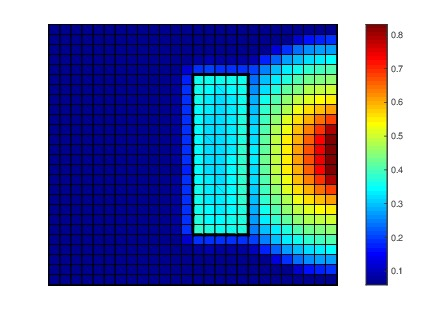
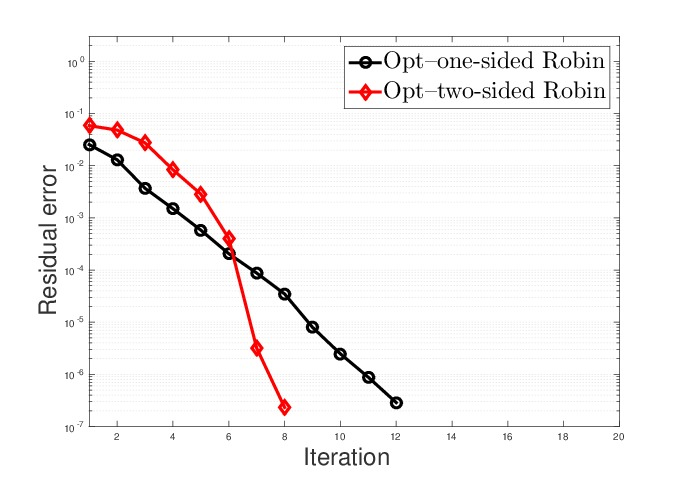
8.2 –Version discontinuous Galerkin methods on essentially arbitrarily-shaped elements.
Participants: Andrea Cangiani, Zhaonan Dong, Emmanuil Georgoulis.
In 50, we extend the applicability of the popular interior-penalty discontinuous Galerkin (dG) method discretizing advection-diffusion-reaction problems to meshes comprising extremely general, essentially arbitrarily-shaped elemens. In particular, our analysis allows for curved element shapes, without the use of non-linear elemental maps. The feasibility of the method relies on the definition of a suitable choice of the discontinuity penalization, which turns out to be explicitly dependent on the particular element shape, but essentially independent on small shape variations. This is achieved upon proving extensions of classical trace inverse estimate to arbitrary element shapes. A further new –-type inverse estimate on essentially arbitrary element shapes enables the proof of inf-sup stability of the method in a streamline diffusion-like norm. These inverse estimates may be of independent interest. A priori error bounds for the resulting method are given under very mild structural assumptions restricting the magnitude of the local curvature of element boundaries. Moreover, we have also developed a GPU library for the massive parallel implemetation of the proposed DG methods, see 57.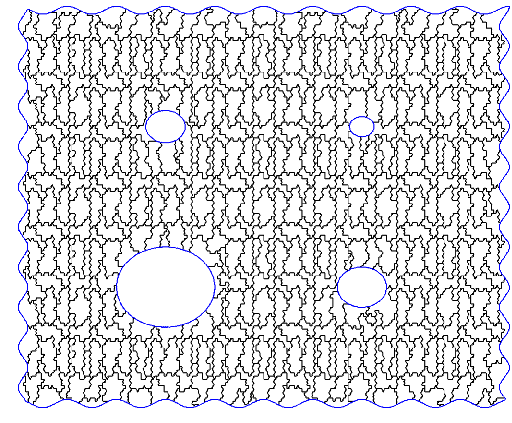
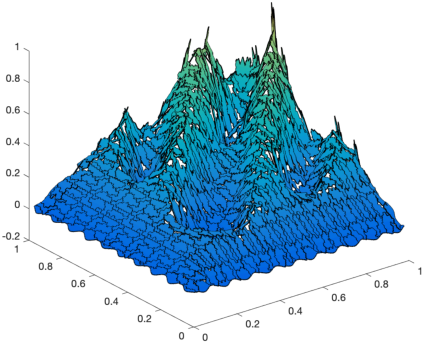
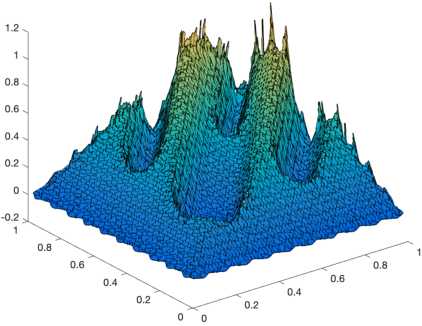
8.3 Residual-based a posteriori error estimates for -discontinuous Galerkin discretisations of the biharmonic problem
Participants: Zhaonan Dong, Lorenzo Mascotto, Oliver Sutton.
In 26, we introduce a residual-based a posteriori error estimator for a novel -version interior penalty discontinuous Galerkin method for the biharmonic problem in two and three dimensions. We prove that the error estimate provides an upper bound and a local lower bound on the error, and that the lower bound is robust to the local mesh size but not the local polynomial degree. The suboptimality in terms of the polynomial degree is fully explicit and grows at most algebraically. Our analysis does not require the existence of a -conforming piecewise polynomial space and is instead based on an elliptic reconstruction of the discrete solution to the space and a generalised Helmholtz decomposition of the error. This is a -version error estimator for the biharmonic problem in two and three dimensions. The practical behavior of the estimator is investigated through numerical examples in two and three dimensions.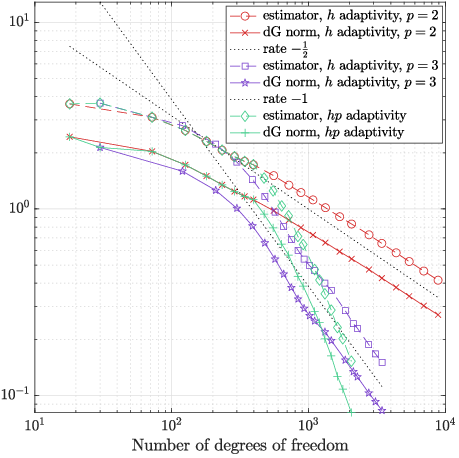
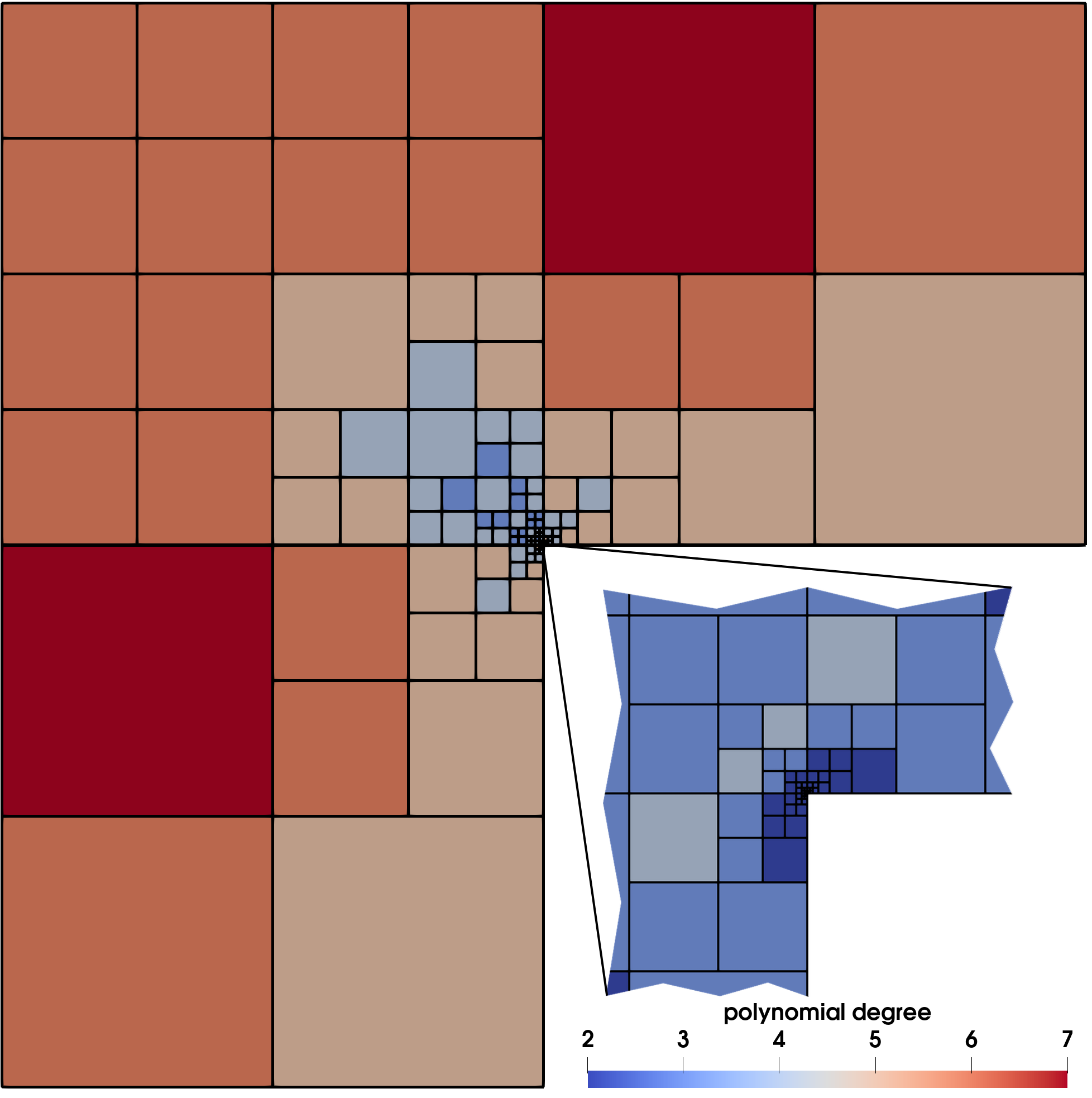
8.4 A-posteriori-steered -robust multigrid with optimal step-sizes and adaptive number of smoothing steps
Participants: Ani Miraçi, Jan Papež, Martin Vohralík.
In 36, we continue our developments started in 35. We in particular develop an iterative algebraic solver of the multigrid type, whose distinctive feature is that it is steered by an a posteriori estimator of the algebraic error. We work in the context of a second-order elliptic diffusion problem discretized by conforming finite elements of arbitrary polynomial degree . In contrast to an established practice, our solver employs no pre-smoothing and solely one post-smoothing step, carried over via the overlapping Schwarz (block-Jacobi) method. Moreover, it features an optimal choice of the step-sizes in the smoothing correction on each level by line search. This leads to a simple Pythagorean formula of the algebraic error in the next step in terms of the current error and level-wise and patch-wise error reductions. We show the two following results and their equivalence: the solver contracts the algebraic error independently of the polynomial degree ; and the estimator represents a two-sided -robust bound on the algebraic error. We consider quasi-uniform or graded bisection simplicial meshes and prove mild dependence on the number of mesh levels for minimal -regularity and complete independence for -regularity. We also present a simple and effective way for the solver to adaptively choose the number of post-smoothing steps necessary at each individual level, yielding a yet improved error reduction. Numerical tests confirm -robustness and show the benefits of the adaptive number of smoothing steps. An illustration of the performance of the developed solver is illustrated in Figure 4 (red boxes), in comparision with some established algorithms.
9 Bilateral contracts and grants with industry
9.1 Bilateral contracts with industry
- Two-part contract with EDF accompanying the PhD thesis of Idrissa Niakh.
- Two-part contract with IFP Energies Nouvelles accompanying the PhD thesis of Joëlle Ferzly.
- A new two-part contract with ANDRA accompanying the PhD thesis of Ari Rappaport (starting in January 2021).
10 Partnerships and cooperations
10.1 International initiatives
Informal international partners
University College London, Great Britain, Texas A&M University, USA, UPC (Spain), Institute of Mathematics, Czech Academy of Sciences, Charles University, Prague, Ecole Nationale d'Ingénieurs de Tunis
10.2 International research visitors
- IIC GUERMOND Jean-Luc
- Title: Curved H(div), H(curl) elements, and magnetohydrodynamics & Approximation of hyperbolic systems
- International Partner (Institution - Laboratory - Researcher):
- Texas A&M University (United States) - Department of Mathematics - Jean-Luc Guermond
- Duration: 2019 - 2023
- Start year: 2019
- See also: https://
www. math. tamu. edu/ ~guermond/ - The program is articulated around two themes: (1) Theoretical aspects in finite elements and applications to multi-physics magneto-hydrodynamics; (2) Finite element approximation of hyperbolic systems and applications. The results from this research will have applications in problems related to porous media flows, magnetohydrodynamics, water management, and compressible and incompressible fluid flows.
10.3 European initiatives
10.3.1 FP7 & H2020 Projects
EMC2
- Title: Extreme-scale Mathematically-based Computational Chemistry
- Duration: 2019 - 2025
- Coordinator: E. Cancès, L. Grigori, Y. Maday, J.-P. Piquemal
-
Partners:
- CENTRE NATIONAL DE LA RECHERCHE SCIENTIFIQUE
- ECOLE NATIONALE DES PONTS ET CHAUSSEES
- Inria
- Sorbonne Université
- Inria contact: L. Grigori
- Summary: The goal of this ERC Synergy is to develop physical and chemical models in chemistry, condensed matter physics, molecular biology, materials science, and nanosciences, altogether with mathematically-certified and numerically-efficient algorithms, and to implement them in a scalable way on various computer architectures.
-
Web page:
https://
erc-emc2. eu/
GATIPOR
- Title: Guaranteed fully adaptive algorithms with tailored inexact solvers for complex porous media flows
- Duration: 2015 - 2021
- Coordinator: M. Vohralík
-
Partners:
- Inria
- Inria contact: M. Vohralík
- Summary: The subject of this ERC consolidator grant are new approaches to porous media multiphase flows: inexact Newton-multigrid solvers, local stopping criteria, adaptivity, and a posteriori error control. The goal is to guarantee the overall simulation error and to speed-up importantly the present-day simulations.
-
Web page:
https://
project. inria. fr/ gatipor/
10.4 Regional initiatives
GiS: scientific collaboration network between ten public institutions from the Paris (Ile-de-France) region, focused on natural resources and environment. The project-team SERENA is a member.
11 Dissemination
11.1 Promoting scientific activities
11.1.1 Scientific events: organisation
General chair, scientific chair
- Guillaume Enchéry and Martin Vohralík have organized a 1-day workshop Journée contrat cadre IFP Energies Nouvelles/Inria.
11.1.2 Scientific events: selection
Member of the conference program committees
- Géraldine Pichot is a member of the Scientific Committee of the SIAM Conference on Mathematical & Computational Issues in the Geosciences (GS21), June 21 -24, 2021, Politecnico di Milano, Italy. Géraldine Pichot was also a member of the Scientific Commitee of FRAME2020 - FRActured MEdia: Numerical methods for fluid flow and mechanics, September 21-24, 2020.
- Alexandre Ern is a member of the Scientific Committee of the European Finite Element Fair (EFEF) and of the European Numerical Mathematics and Advanced Applications Conference (ENUMATH).
- Michel Kern was a member of the Program Comittee of JCAD2019, Journées Calcul et Données .
11.1.3 Journal
Member of the editorial boards
- Alexandre Ern is a member of the editorial boards of SIAM Journal on Scientific Computing, ESAIM Mathematical Modelling and Numerical Analysis, IMA Journal of Numerical Analysis, Journal of Scientific Computing, and Computational Methods in Applied Mathematics.
- Martin Vohralík is a member of the editorial boards of Acta Polytechnica and Applications of Mathematics.
Reviewer - reviewing activities
- Zhaonan Dong was a reviewer for the journals: SIAM Journal on Numerical Analysis, ESAIM: Mathematical Modelling and Numerical Analysis, Calcolo, International Journal for Numerical Methods in Engineering, and Journal of Scientific Computing.
- Michel Kern was a reviewer for the journals: Transport in Porous Media, Computer Methods in Applied Mechanics and Engineering, BIT, Mathematics and Computers in Simulation,
- Alexandre Ern and Martin Vohralík served as reviewers for dozens of papers in different journals.
11.1.4 Invited talks
- Michel Kern, talk at the Workshop on Recent Developments in Modelling, Analysis, and Simulation of Processes in Porous Media, University of Erlangen–Nürmberg, March 5-6 2020.
- Martin Vohralík was an invited speaker at Finite Volumes for Complex Applications IX, Bergen, Norway, June 2020, PANM 2020, Hejnice, Czech Republic, June 2020, and InterPore 2020, online, September 2020,
11.1.5 Leadership within the scientific community
- Alexandre Ern is the coordinator of the Master Mathématiques et applications, Ecole nationale des ponts et chaussées.
- Michel Kern was Chair of the selection committee for the SIAM Activity Group on Geosciences Career Prize.
- Michel Kern is a member of the Committee on Committees and Appointments of SIAM.
- Martin Vohralík is a member of the steering committee of Summer schools CEA–EDF–INRIA.
- Martin Vohralík is a member of the scientific board of the IFP Energies Nouvelles– Inria joint strategic partnership laboratory.
- Martin Vohralík is in charge of the topic “Numerical schemes, mesh generation algorithms, and error control” in the ANDRA, BRGM, CEA, EDF, IFP Energies Nouvelles, and Total working group on High-Performance Numerical Simulation in the Geosciences (identification of common challenges and collaboration opportunities).
11.1.6 Research administration
- François Clément is member of the Comité local d'hygiène, de sécurité et des conditions de travail (CLHSCT) of the Inria Research Center of Paris.
- Géraldine Pichot was a member of the selection committee of the Maître de Conférence (MCF 26e) position at Université de technologie de Troyes (UTT), Mai 2020.
- Michel Kern is in charge of the Comission de Développement Technologique of the Inria Research Center of Paris.
11.2 Teaching - Supervision - Juries
11.2.1 Teaching
- Licence : Alexandre Ern, Numerical analysis, 77h, L3/M1, Ecole Polytechnique, France.
- Master : Alexandre Ern, Discontinuous Galerkin methods, 20h, M2, Sorbonne University, France.
- Master: Michel Kern, Models and numerical methods for subsurface flow, 30h, M2, Université Paris Saclay, France.
- Master: Michel Kern, Inverse Problems, 24h, M1, Mines-ParisTech, France.
- Master: Michel Kern, Advanced numerical analysis, 30h, M1, Institut Galilée, Université Paris-Nord, France.
- Master: Martin Vohralík, A posteriori error estimates for efficiency and error control in numerical simulations, 36h, M2, Charles University, Prague, Czech Republic.
- Master: Martin Vohralík, Advanced finite elements, 21h, M1, Ecole nationale supérieure de techniques avancées, Paris, France.
11.2.2 Supervision
- PhD defended on May 29, 2020: Frédéric Marazzato, Discrete element methods for fracture and fragmentation, Alexandre Ern.
- PhD defended on December 16, 2020: Riccardo Milani, Compatible Discrete Operator schemes for Navier–Stokes equations, Alexandre Ern.
- PhD defended on December 14, 2020: Ani Miraçi, A-posteriori-steered and adaptive -robust multigrid solvers, Martin Vohralík and Alexandre Ern.
- PhD in progress: Joëlle Ferzly, A posteriori error estimates and adaptivity for complementarity problems, started 15 October 2019, Martin Vohralík.
- PhD in progress: Idrissa Niakh, Reduced models for variational inequalities in computational mechanics, started 01 November 2019, Alexandre Ern and Virginie Ehrlacher (ENPC).
- PhD in progress: Stefano Piccardo, High-fidelity simulation of droplets in complex shear flows, started 01 October 2019, Alexandre Ern and Antonio Huerta (UPC).
- PhD in progress: Morgane Steins, Hybrid High Order methods for explicit dynamics of structures with adaptive mesh refinement, started 01 October 2020, Alexandre Ern and Martin Vohralík.
- Internship: Nathanael Tepakbong, from March 2020 until July 2020, ParaCirce: logiciel de génération de champs aléatoires Gaussiens, Géraldine Pichot.
- Internship: Théo Kaprélian, from September 2019 until February 2020, An -adaptive strategy in dimension one taking into account the cost of the resolution, Martin Vohralík.
11.2.3 Juries
- Géraldine Pichot, Examiner, PhD Quentin Van Aken, Université de technologie de Troyes (UTT), September 2020.
- Michel Kern, Examiner, PhD Bastien Hamlat, September 2020
11.3 Popularization
11.3.1 Internal or external Inria responsibilities
- Géraldine Pichot is a member of the editorial committee of Interstices.
11.3.2 Interventions
- Géraldine Pichot, Conference au RJMI (Rendez-vous des Jeunes Mathématiciennes et Informaticiennes), October 27, 2020.
- Michel Kern, online presentation about Numerical Simulation as part of the Parlons Maths program for high school students
12 Scientific production
12.1 Major publications
- 1 articleA posteriori error estimates and stopping criteria for space-time domain decomposition for two-phase flow between different rock typesSMAI Journal of Computational Mathematics5December 2019, 195-227
- 2 articleTrusting computations: A mechanized proof from partial differential equations to actual programComputers and Mathematics with Applications683August 2014, 325--352
- 3 articleWave equation numerical resolution: a comprehensive mechanized proof of a C programJournal of Automated Reasoning504April 2013, 423--456
- 4 articleGuaranteed and robust a posteriori bounds for Laplace eigenvalues and eigenvectors: conforming approximationsSIAM Journal on Numerical Analysis555September 2017, 2228-2254
- 5 unpublishedhp -Version discontinuous Galerkin methods on essentially arbitrarily-shaped elementsJanuary 2021, working paper or preprint
- 6 articleA hybrid high-order locking-free method for linear elasticity on general meshesComput. Methods Appl. Mech. Engrg.2832015, 1--21URL: http://dx.doi.org/10.1016/j.cma.2014.09.009
- 7 articleFinite element quasi-interpolation and best approximationESAIM Math. Model. Numer. Anal.5142017, 1367--1385URL: https://doi.org/10.1051/m2an/2016066
- 8 articlePolynomial-degree-robust a posteriori estimates in a unified setting for conforming, nonconforming, discontinuous Galerkin, and mixed discretizationsSIAM Journal on Numerical Analysis532April 2015, 1058-1081
- 9 articleSpace-time domain decomposition methods for diffusion problems in mixed formulationsSIAM J. Numer. Anal.5162013, 3532--3559URL: http://dx.doi.org/10.1137/130914401
- 10 articleA generalized mixed hybrid mortar method for solving flow in stochastic discrete fracture networksSIAM J. Sci. Comput.3412012, B86--B105URL: http://dx.doi.org/10.1137/100804383
12.2 Publications of the year
International journals
Conferences without proceedings
Doctoral dissertations and habilitation theses
Reports & preprints

